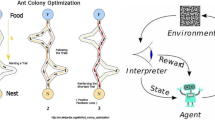Abstract
Application of the ant algorithm for ensuring the cyber resilience of a distributed system in conditions of various types of cyber attacks is considered. The principle of operation of the ant algorithm is described, a mathematical model of the network infrastructure is developed, and possible types of cyberattacks are determined within the framework of the model. The results of the experimental studies demonstrated the applicability of the ant algorithm for ensuring the cyber resilience of large-scale networks.





Similar content being viewed by others
REFERENCES
Markov, Y.A., Kalinin, M.O., and Zegzhda, D.P., A technique of abnormal behavior detection with genetic sequences alignment algorithms, International Conference on Enterprise Information Systems and Web Technologies, EISWT 2010, 2010, pp. 104–110.
Lavrova, D.S., Maintaining cyber sustainability in industrial systems based on the concept of molecular-genetic control systems, Autom. Control Comput. Sci., 2019, vol. 53, no. 8, pp. 1026–1028.
Zegzhda, P., Zegzhda, D., Kalinin, M., Pechenkin, A., Minin, A., and Lavrova, D., Safe integration of SIEM systems with Internet of Things: Data aggregation, integrity control, and bioinspired safe routing, ACM International Conference Proceeding Series, 2016, pp. 81–87. https://doi.org/10.1145/2947626.2947639
Lavrova, D., Zaitceva, E., and Zegzhda, P., Bio-inspired approach to self-regulation for industrial dynamic network infrastructure, CEUR Workshop Proc., 2019, vol. 2603, pp. 34–39.
Benaicha, S.E., et al., Intrusion detection system using genetic algorithm, Science and Information Conference, London, 2014, pp. 564–568.
Zou, Q., et al., Ant colony optimization algorithm in intrusion detection and positive, Appl. Mech. Mater., Trans Tech Publ., 2014, vol. 443, pp. 541–545.
Chen, H.H., et al., LDDoS attack detection by using ant colony optimization algorithms, J. Inf. Sci. Eng., 2016, vol. 32, no. 4, pp. 995–1020.
Kalinin, M.O., Zubkov, E.A., Suprun, A.F., and Pechenkin, A.I., Prevention of attacks on dynamic routing in self-organizing adhoc networks using swarm intelligence, Autom. Control Comput. Sci., 2018, vol. 52, no. 8, pp. 977–983.
Krundyshev, V., Kalinin, M., and Zegzhda, P., Artificial swarm algorithm for VANET protection against routing attacks, 2018 IEEE Industrial Cyber-Physical Systems, ICPS 2018, 2018, pp. 795–800.
Kalinin, M., Demidov, R., and Zegzhda, P., Hybrid neural network model for protection of dynamic cyber infrastructure, Nonlinear Phenom. Complex Syst. (Dordrecht, Neth.), 2019, vol. 22, no. 4, pp. 375–382.
Lavrova, D., Zegzhda, D., and Yarmak, A., Using GRU neural network for cyber-attack detection in automated process control systems, IEEE International Black Sea Conference on Communications and Networking (BlackSeaCom), Sochi, 2019, pp. 1–3.
Zegzhda, P., Zegzhda, D., Pavlenko, E., and Ignatev, G., Applying deep learning techniques for android malware detection, ACM International Conference Proceeding Series, 2018. https://doi.org/10.1145/3264437.3264476
Belenko, V., Chernenko, V., Kalinin, M., and Krundyshev, V., Evaluation of GAN applicability for intrusion detection in self-organizing networks of cyber physical systems, 2018 International Russian Automation Conference, RusAutoCon, 2018. https://doi.org/10.1109/RUSAUTOCON.2018.8501783
Krundyshev, V. and Kalinin, M., Hybrid neural network frame work for detection of cyber attacks at smart infrastructures, ACM International Conference Proceeding Series, 2019. https://doi.org/10.1145/3357613.3357623
Ovasapyan, T.D., Moskvin, D.A., and Kalinin, M.O., Using neural networks to detect internal intruders in vanets, Autom. Control Comput. Sci., 2018, vol. 52, no. 8, pp. 954–958.
Yong, S.Z., Foo, M.Q., and Frazzoli, E., Robust and resilient estimation for cyber-physical systems under adversarial attacks, American Control Conference (ACC), Boston, MA, 2016, pp. 308–315.
Thiede, S., Environmental sustainability of cyber physical production systems, Procedia CIRP, 2018, vol. 69, pp. 644–649.
Zegzhda, D.P., Zegzhda, P.D., and Kalinin, M.O., Clarifying integrity control at the trusted information environment, Lect. Notes Comput. Sci., 2010, vol. 6258, pp. 337–344.
Lavrova, D., Zegzhda, D., and Yarmak, A., Predicting cyber attacks on industrial systems using the Kalman filter, 3rd World Conference on Smart Trends in Systems, Security and Sustainability, WorldS4 2019, 2019, pp. 317–321.
Pavlenko, E.Y., Yarmak, A.V., and Moskvin, D.A., Hierarchical approach to analyzing security breaches in information systems, Autom. Control Comput. Sci., 2017, vol. 51, no. 8, pp. 829–834.
Zegzhda, D.P. and Pavlenko, E.Y., Cyber-sustainability of software-defined networks based on situational management, Autom. Control Comput. Sci., 2018, vol. 52, no. 8, pp. 984–992.
Stepanova, T., Pechenkin, A., and Lavrova, D., Ontology-based big data approach to automated penetration testing of large-scale heterogeneous systems, ACM International Conference Proceeding Series, 2015. https://doi.org/10.1145/2799979.2799995
Zegzhda, D., Lavrova, D., and Poltavtseva, M., Multifractal security analysis of cyberphysical systems, Nonlinear Phenom. Complex Syst. (Dordrecht, Neth.), 2019, vol. 22, no. 2, pp. 196–204.
Dorigo, M., Optimization, learning and natural algorithms, PhD Thesis, Politecnico di Milano, 1992.
Shtovba, S.D., Ant algorithms: Theory and application, Programmirovanie, 2005, vol. 31, no. 4, pp. 3–18.
Drigo, M., The ant system: Optimization by a colony of cooperating agents, IEEE Trans. Syst. Man Cybern. B, 1996, vol. 26, no. 1, pp. 1–13.
Dorigo, M., Bonabeau, E., and Theraulaz, G., Ant algorithms and stigmergy, Future Gener. Comput. Syst., 2000, vol. 16, no. 8, pp. 851–871.
Funding
The research was carried out within the framework of scholarships of the President of the Russian Federation for young scientists and graduate students SP-1689.2019.5.
Author information
Authors and Affiliations
Corresponding author
Ethics declarations
The authors declare that they have no conflicts of interest.
Additional information
Translated by K. Lazarev
About this article
Cite this article
Pavlenko, E.Y., Kudinov, K.V. Ensuring Cyber Resilience of Large-Scale Network Infrastructure Using the Ant Algorithm. Aut. Control Comp. Sci. 54, 793–802 (2020). https://doi.org/10.3103/S0146411620080258
Received:
Revised:
Accepted:
Published:
Issue Date:
DOI: https://doi.org/10.3103/S0146411620080258




